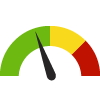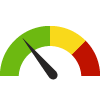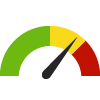Impact 1: Increased Inventory of Housing, Especially Affordable Housing
The community indicators on this page provide an overview of how Santa Cruz County residents are doing in key areas of this community impact. This helps us understand how our community is doing overall, and whether particular people or areas in the county are experiencing greater challenges or hardships that need to be addressed. To learn more about any community indicator, click See More Data.
Indicator
See More Data
Severe Housing Problems
This indicator measures the percentage of households with at least one of the following four housing problems: overcrowding, high housing costs, lack of kitchen, or lack of plumbing facilities.
Severe Housing Problems
County: Santa Cruz
Indicator
See More Data
Housing Cost Burden
Spending a high percentage of household income on housing can create financial hardship, especially for lower-income homeowners. With a limited income, high monthly housing costs may not leave enough money for other expenses, such as food, transportation and medical. Moreover, high housing costs reduce the proportion of income a household can allocate to savings each month.
Mortgaged Owners Spending 30% or More of Household Income on Housing
County: Santa Cruz
Indicators
See More Data
Rental Housing Affordability
Spending a high percentage of household income on rent can create financial hardship, especially for lower-income renters. With a limited income, paying a high rent may not leave enough money for other expenses, such as food, utilities, transportation and medical.
Indicators
See More Data
Home Affordability
shows the ratio between the average spending among households that spent on homeowner expenses and the median household income in the selected location. This includes spending on mortgage interest, property tax, insurance, and maintenance.
Indicator
See More Data
Utilization of Housing Choice Vouchers
The housing choice voucher program (formally known as Section 8) is a a federal housing assistance program meant to assist very low-income families, the elderly, and the disabled with affording decent, safe, and sanitary housing in the private market.
Utilization of Housing Choice Vouchers
County: Santa Cruz
INDICATOR
See More Data
Overcrowded Housing
People forced by poverty into overcrowded homes are much more likely to be people of color, due to discriminatory housing, education and banking policies that have segregated neighborhoods and prevented non-white families from amassing wealth.
Overcrowded Households
County: Santa Cruz
Indicator
See More Data
Loss of housing among older & dependent adults
The Elder Economic Security Standard Index is a more comprehensive assessment of economic insecurity than the Federal Poverty Level (FPL) guidelines and reflects actual costs at the county level for housing, health care, food, transportation, and other costs in different housing types. More information about how the Index is calculated is available in the UCLA methodology report.
Elder Index (Elderly Household Below Income Threshold)
County: Santa Cruz
Indicator
See More Data
People 65+ Living Alone
People over age 65 who live alone may be at risk for social isolation, limited access to support, or inadequate assistance in emergency situations. Older adults who do not live alone are most likely to live with a spouse, but they may also live with a child or other relative, a non-relative, or in group quarters. The Commonwealth Fund Commission on the Elderly Living Alone indicated that one third of older Americans live alone, and that one quarter of those living alone live in poverty and report poor health.
People 65+ Living Alone
County: Santa Cruz
Indicators
Growth in Housing Units; Diversity in Units
Data unavailable at this time
Indicators
Growth in Low-Income and Affordable Housing Units
Data unavailable at this time
Indicators
Loss of Working Adults (Ages 25-55) Due to Housing Costs
Data unavailable at this time



















